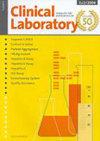Methods Comparison and Bias Estimation of Three Distinct Biochemistry Analytical Systems in One Clinical Laboratory Using Patient Samples.
IF 0.7
4区 医学
Q4 MEDICAL LABORATORY TECHNOLOGY
引用次数: 6
Abstract
BACKGROUND In China, one laboratory usually owns more than one diagnostic device or reagent kit measuring the same analyte and this situation causes great troubles for quality control and traceability. To determine if the different devices yield equivalent results, the correlation coefficients and predicted bias between three distinct bio-chemistry analyzers in our lab were evaluated. METHODS 40 analytes were detected and used to evaluate method performance and comparability of results between different analyzers. The Vitros5600 and Hitachi7170 analyzers were separately compared with the Cobas 8000 analyzer according to Clinical and Laboratory Standards Institute (CLSI) guideline (EP9-A2). Within-day and between-day imprecision of the three analytical systems were calculated in accordance with CLSI guidelines EP15-A2. RESULTS Comparing the Hitachi7170 with Cobas8000 analyzer, except for calcium, magnesium, chloride ion (CL-), and carbon dioxide, the other 36 analytes were closely correlated (R2 > 0.95), while 4 of the 36 analytes' predicted bias exceeded the acceptable criteria. As for the Vitros5600 and Cobas8000, except for albumin, sodium ion (NA+), magnesium, and chloride (CL), the other 13 analytes were closely correlated (R2 > 0.95), while 5 of the 13 analytes' predicted bias exceeded the acceptable criteria. CONCLUSIONS Significant differences for several analytes between distinct analyzers were found; for some analytes the predicted bias between dry chemical analyzer and conventional wet chemical analyzer can reach 30%, which is worthy of our concern. When one analyte was detected on more than one device, a strict method comparison study should be performed regularly. Reference intervals should be validated and transferred from the Cobas 8000 to Vitros5600 when the bias cannot be adjusted.方法在同一临床实验室使用患者样本进行三种不同生化分析系统的比较和偏倚估计。
在中国,一个实验室通常拥有多个诊断设备或试剂盒来检测同一种分析物,这种情况给质量控制和可追溯性带来了很大的麻烦。为了确定不同的设备是否产生等效的结果,我们评估了实验室中三种不同生化分析仪之间的相关系数和预测偏差。方法对40个分析物进行检测,评价方法的性能和不同分析仪之间结果的可比性。根据临床和实验室标准协会(CLSI)指南(EP9-A2),分别将Vitros5600和Hitachi7170分析仪与Cobas 8000分析仪进行比较。根据CLSI指南EP15-A2计算三种分析系统的日内和日间不精确度。结果将Hitachi7170与Cobas8000分析仪进行比较,除钙、镁、氯离子(CL-)和二氧化碳外,其余36个分析物的预测偏差均密切相关(R2 > 0.95),其中4个分析物的预测偏差超出可接受标准。对于Vitros5600和Cobas8000,除白蛋白、钠离子(NA+)、镁和氯离子(CL)外,其余13种分析物密切相关(R2 > 0.95), 13种分析物中有5种预测偏差超过可接受标准。结论不同分析仪间的分析结果存在显著性差异;对于某些分析物,干法化学分析仪与常规湿法化学分析仪的预测偏差可达30%,值得我们关注。当在多个设备上检测到一种分析物时,应定期进行严格的方法比较研究。当偏置无法调整时,应验证参考区间并将其从Cobas 8000转移到Vitros5600。
本文章由计算机程序翻译,如有差异,请以英文原文为准。
求助全文
约1分钟内获得全文
求助全文
来源期刊

Clinical laboratory
医学-医学实验技术
CiteScore
1.50
自引率
0.00%
发文量
494
审稿时长
3 months
期刊介绍:
Clinical Laboratory is an international fully peer-reviewed journal covering all aspects of laboratory medicine and transfusion medicine. In addition to transfusion medicine topics Clinical Laboratory represents submissions concerning tissue transplantation and hematopoietic, cellular and gene therapies. The journal publishes original articles, review articles, posters, short reports, case studies and letters to the editor dealing with 1) the scientific background, implementation and diagnostic significance of laboratory methods employed in hospitals, blood banks and physicians'' offices and with 2) scientific, administrative and clinical aspects of transfusion medicine and 3) in addition to transfusion medicine topics Clinical Laboratory represents submissions concerning tissue transplantation and hematopoietic, cellular and gene therapies.
 求助内容:
求助内容: 应助结果提醒方式:
应助结果提醒方式:


